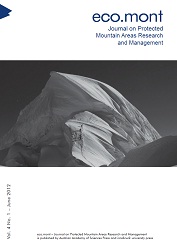
Eco.mont Vol. 4 Nr. 1, pp. 23-33, 2012/06/01
Journal on Protected Mountain Areas Research and Management

Protected areas in the Alps are dissected by high-traffic roads for tourist access and transit. Road construction leaves disturbed areas with open soil, which may serve as starting points for the invasion of alien plants or ruderal lowland plants into the protected mountain habitats. In the 1960s, a transit road was widened in the Swiss National Park (SNP) and disturbed roadsides were sown with mixtures of grassland species. Roadside development and vegetation dynamics in the adjacent subalpine pine (Pinus mugo) forest were monitored in permanent plots from 1969 till 2010. Over the 42-year monitoring period, the sown species disappeared progressively and were replaced by species from naturally disturbed areas as well as by forest species. A standard seed mixture and native seeds introduced with local hay developed similarly. Sown species did not expand into the natural habitats and no alien species colonized the roadsides, despite the long-term persistence of open soil. The impact of roadsides on the local flora was therefore minimal. Ecological indicator values suggest that the development of roadsides in the SNP was determined by harsh conditions resulting from a continental subalpine climate and poorly developed soils on dolomite. Therefore, the developments observed in the SNP and the proposed low impact of roadsides on the natural vegetation may not hold for other Alpine regions with different geology and a more oceanic climate.
Keywords: disturbance neophytes road-construction restoration succession Swiss-National-Park